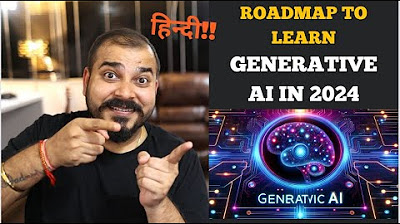Complete Road Map To Prepare NLP-Follow This Video-You Will Able to Crack Any DS Interviews🔥🔥
Summary
TLDRIn this video, Krishna presents a comprehensive roadmap for preparing for Natural Language Processing (NLP). He emphasizes the importance of NLP in data science and its growing demand among recruiters. Krishna breaks down the preparation process into a bottom-up approach, starting from basic text preprocessing techniques like tokenization, stemming, and lemmatization. He progresses to advanced concepts like converting words to vectors, word embeddings, and recurrent neural networks (RNNs), including LSTMs and Transformers. Krishna also introduces useful libraries such as NLTK, SpaCy, PyTorch, and Hugging Face. Viewers are encouraged to follow the step-by-step guide to successfully clear data science interviews.
Takeaways
- 😀 The video provides a comprehensive roadmap for preparing for a career in Natural Language Processing (NLP).
- 🔍 NLP is highly sought after in the job market due to its applicability in various fields alongside machine learning and deep learning.
- 📚 The presenter suggests starting with basic text preprocessing and gradually moving to advanced topics like word embeddings and neural networks.
- 💡 Text preprocessing involves techniques such as tokenization, stemming, lemmatization, and understanding stop words and POS tagging.
- 📈 The video emphasizes the importance of converting text into vectors using methods like Bag of Words, TF-IDF, and advanced vector representations like Word2Vec.
- 🧠 A strong foundation in deep learning concepts like ANN, loss functions, gradient descent, and optimizers is crucial for advanced NLP.
- 🔗 The presenter introduces libraries such as NLTK, SpaCy, PyTorch, TensorFlow, and Hugging Face for implementing NLP tasks.
- 📝 Practical applications of NLP include sentiment analysis, spam detection, document classification, and chatbots, which are also covered in the video.
- 🔁 The video discusses the evolution from simple RNNs to LSTM, GRU, and advanced models like Transformers and BERT for handling sequence data more effectively.
- 📹 The presenter has prepared playlists covering both the theoretical and practical aspects of NLP, guiding viewers from basics to advanced topics.
Q & A
What is the main focus of the video by Krishna?
-The main focus of the video is to provide a comprehensive roadmap for preparing for Natural Language Processing (NLP) interviews, highlighting the importance of NLP in data science and machine learning.
Why is NLP considered important in the field of data science?
-NLP is important because it can be integrated with machine learning and deep learning, and there is a growing demand for NLP skills as per recent surveys, making it a top priority for recruiters.
What are some libraries recommended for NLP in the video?
-The video suggests using libraries like NLTK for natural language analysis, SpaCy for machine learning tasks, and Hugging Face for transformer models. It also mentions PyTorch, TensorFlow, and Keras for deep learning.
What is the significance of text pre-processing in NLP?
-Text pre-processing is crucial as it involves converting raw text data into a format that machine learning models can understand, such as tokenization, stemming, lemmatization, and handling stop words.
How does the video suggest one should approach learning NLP?
-The video suggests a bottom-to-top approach, starting with basic text pre-processing and gradually moving to advanced techniques like word embeddings, deep learning concepts, and transformer models.
What are some of the machine learning algorithms mentioned for NLP tasks?
-The video mentions using Naive Bayes classifier and Multinomial Naive Bayes for sentiment analysis, spam filtering, and document classification.
Can you explain the role of RNNs in NLP as discussed in the video?
-RNNs (Recurrent Neural Networks) are important in NLP because they can handle sequences of data, making them suitable for tasks involving time series or sentences where the order of words matters.
What is the purpose of word embeddings in NLP?
-Word embeddings are used to efficiently convert words into vectors, capturing semantic meanings and relationships between words, which is essential for tasks like text classification and machine translation.
How does the video address the transition from traditional machine learning to deep learning in NLP?
-The video outlines a progression from basic NLP techniques to deep learning by first understanding machine learning algorithms and then building a strong foundation in deep learning concepts like ANN, loss functions, and optimizers.
What are some advanced topics covered in the video for NLP?
-The video covers advanced topics such as LSTM (Long Short-Term Memory), GRU (Gated Recurrent Units), bidirectional LSTM, sequence-to-sequence models, self-attention mechanisms, and Transformers.
What is the significance of BERT in the context of this video?
-BERT (Bidirectional Encoder Representations from Transformers) is highlighted as an advanced model that extends the capabilities of Transformers, focusing on understanding the context of words within a sentence for improved NLP tasks.
Outlines

このセクションは有料ユーザー限定です。 アクセスするには、アップグレードをお願いします。
今すぐアップグレードMindmap

このセクションは有料ユーザー限定です。 アクセスするには、アップグレードをお願いします。
今すぐアップグレードKeywords

このセクションは有料ユーザー限定です。 アクセスするには、アップグレードをお願いします。
今すぐアップグレードHighlights

このセクションは有料ユーザー限定です。 アクセスするには、アップグレードをお願いします。
今すぐアップグレードTranscripts

このセクションは有料ユーザー限定です。 アクセスするには、アップグレードをお願いします。
今すぐアップグレード関連動画をさらに表示

Roadmap to Learn Generative AI(LLM's) In 2024-Krish Naik Hindi #generativeai

Natural Language Processing (Part 1): Introduction to NLP & Data Science

How I'd Learn NLP in 2024 (If I Had to Start Over)

Introduction to Natural Language Processing in Hindi ( NLP ) 🔥

Complete Detailed Roadmap To Learn AI In 2025 With Free Videos And Resources

Natural Language Processing in Artificial Intelligence in Hindi | NLP with Demo and Examples
5.0 / 5 (0 votes)
